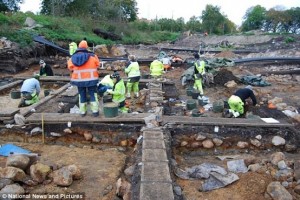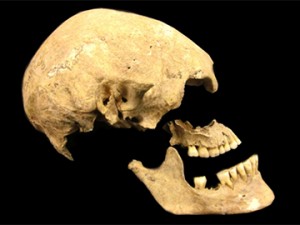For many years, we believed that Europeans descended from early farmers, who were originally in the Middle East and moved to Europe about 7,500 years ago, or from local hunter-gatherers that bred with other races. However, recent DNA analysis uncovers a third group.
Nine ancient skeletons found in Sweden, Germany, and Luxemburg were of seven hunter-gathers and one hunter who lived 8,000 years ago and one farmer who lived 7,000 years ago. Through association, the hunter-gatherers were labeled as hunter-gatherers and identified as being from the same time period. Hunter-gatherers had darker skin than farmers and typically blue eyes, while farmers had fair to pale skin tones.
The skeletal remains were dated with AMS radiocarbon dating, a method applied to organic matter based on carbon decay. AMS radiocarbon dating uses an accelerator mass spectrometer to differentiate the carbon isotopes from other atoms or molecules that have a similar mass. A danger of radiocarbon dating is that samples can be contaminated, which causes problems with the interpretation of the results. Therefore, the archaeologists used numerous approaches to search for contamination.

Figure 1: Archaeologists from Harvard Medical School collect genetic data from ancient skeletons in Sweden.
The team from the Harvard Medical School and Germany’s University of Tübingen noted a significant genetic transition between the era of hunter-gatherers and the era of the farmers. Thus, North Eurasians contributed to the gene pool in both Europe and North America. After overlaying the genomes with genetic codes from 2,300 present-day people living all over the world, the team concluded that the ancient North Eurasian ancestry is predominant in less than 20 percent of most Europeans’ DNA today. This ancestry is found in nearly every European group, the Caucasus, and the Near East. Northern Europeans have relatively more hunter-gather ancestry than southern Europeans who have more farmer ancestry. Most native Europeans have a mixture of genetic information from the three distinct types of ancestors. Most of the conclusions about the North Eurasian group come from DNA dating and analysis. Concerning the determination of dates, context is extremely important. Therefore, demographic history and inbreeding were accounted for during the process. The researchers focused on sex determination through Y-chromosome analysis. Other methods involved in their DNA dating were enrichment of mitochondrial DNA and shotgun sequencing, which sequences long strands of DNA.
Also, the ancient North Eurasian group explains the genetic connection between Europeans and Native Americans. Remains of ancient Siberians showed that European contributors were from the group that crossed the Bering Straight into the Americas more than 15,000 years ago. This new discovery alters our knowledge about European genetic ancestry and paints a different portrait of modern Europeans’ genetic composition.
Sources:
http://www.archaeology.org/news/2525-140918-european-genetic-ancestry
http://news.discovery.com/human/dna-places-third-group-in-european-descendent-mix-140918.htm
Renfrew, Colin and Paul Bahn (2010) Archaeology Essentials. 2nd edition. Thames & Hudson, New York. Chapter 2.
Figure 1: http://www.archaeology.org/news/2525-140918-european-genetic-ancestry
Further Reading:
http://hms.harvard.edu/news/new-branch-added-european-family-tree
http://www.nature.com/nature/journal/v513/n7518/full/nature13673.html#methods


This research reveals the many ways that “multiplicity” is evident in archaeology. Firstly, the researchers employed a variety of methods in order to best analyze the origins of the bones. You note that the archaeologists used a combination of AMS radiocarbon dating, Y-chromosome analysis, the enrichment of mitochondrial DNA and shotgun sequencing within the context of a single in order to both reach more accurate conclusions and preserve the state of the artifacts. This variety not only allows for the archaeologists to access a greater breadth of knowledge, but also enables them to confirm their findings through comparisons between different methods.
In addition to the variety of practical methods employed, this research also reveals multiplicity in the archaeologist’s analytical framework. The excavation and analysis disrupted previously accepted and reductive assumptions about the genetic origins of Europeans. Instead of conceptualizing European origins in terms of a monolithic European society that originated from a monolithic Middle Eastern, they acknowledge the number of communities evident within in these societies. As a result, a complex networks of people and relationships becomes clear
Whenever skin, hair, and eye color get correlated with a way of life I wonder who is behind such research and why are they making these connections. Just because new DNA techniques can determine how an individual looked doesn’t mean this is valuable information for understanding groups. The heritability of these traits is complex (neither of my parents have blue eyes yet I do) and we know that groups interbred. How many DNA samples would we need to classify all Vassar College students as having a particular skin, hair, and eye color? I suspect the researchers leading the study you cited were not anthropologists or they would have been more reluctant to draw such conclusions.
The multiplicity in archaeology helps by generating a vast collection of analysis. The comparison of the results from the different methods potentially allows for limited error. With technological developments, multiplicity will only increase. However, I wonder if multiplicity is ever bad given that there is more of an opportunity for an error to occur during analysis with so many methods happening. With multiplicity, one error could affect the entire analysis since it is being compared to the other results. Multiplicity is necessary to achieve a full picture of human history, but it may also have downfalls, creating more chaos from one mistake.
The researchers of this study were a mixture geneticists and anthropologists. I find it interesting that anthropologists do not try to discover what the people looked like. While looks do not reveal how the people lived their lives, it adds to the picture of the past, helping us see how we evolved. However, there is more information that could help us today in relation to way of life.